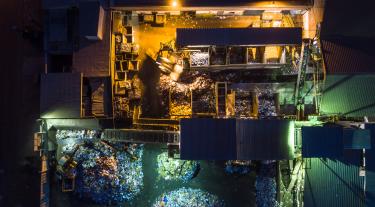The Covid-19 crisis has accelerated political forces already in play towards protectionism and isolationism, as societies have scrambled to plug gaps in the normal functioning of global trade and restore shortages of key necessities.
While the movement of goods has recovered to a degree with the lifting of lockdowns in many countries, especially China, volumes remain 7.3% below the previous year's value . The movement of people, however, is unlikely to recover to pre-pandemic levels for a long time to come.
Many companies have experienced losses as a result of disruption to their global supply chains – with long, linear supply chains propagating this disruption around the world in a matter of days and weeks. As a result, these companies are now likely to be considering options to de-globalise and shorten supply chains – reducing risk by bringing them closer to home. However, if they don’t also address the linearity of their supply chains, then this could result in both higher economic cost and sub-optimal environmental benefits.
The limitations of merely shortening supply chains
Shortening supply chains will certainly reduce the transportation distances required to ship goods but, for consumer-facing goods at least, this is typically only a small portion of the overall value chain carbon impact. For apparel companies, transportation will typically represent 7-12% of total value chain carbon emissions, for supermarkets it is 3-5%, and for consumer durables, including automotive and electronics, this falls to 0.5-1.5% (based on Carbon Trust data).
Given this, shorter supply chains will not alone deliver the kind of carbon reductions required for a net zero recovery.
In addition, while efforts to shorten supply chains of many industries will typically bring Tier 1 and Tier 2 suppliers closer together, the raw material extraction elements of the supply chain are often extremely difficult to change. This is because these tend to be more location dependent, for reasons of climate for agricultural commodities, or reserves for mining commodities. This aspect of the supply chain is often the biggest challenge to decarbonisation and cannot be solved by shortening.
Carbon Trust data shows that in the apparel and automotive sectors around 80% of upstream supply chain emissions exist beyond Tier 1 suppliers; for food and drink or electronics, this split is closer to 65% beyond Tier 1 (and higher for intensive products such as meat and dairy). It’s not possible to reduce these impacts by shortening supply chains.
In order to both decarbonise and shorten supply chains, a fundamental shift in their structure is required – specifically, there must be a greater focus on circularity. Circular business models maintain and retain the value of resources and products to minimise waste and maximise their utility. This includes a range of actions that extend the useful life of products (such as re-conditioning and re-manufacturing); increase value from product use (such as sharing or service-based models); and recover value from products and materials – turning ‘end of life’ into ‘end of first cycle’.
The future is circular
The benefits of a circular approach are many:
- Circularity creates greater self-sufficiency while avoiding the cost lock-ins of merely replicating old, but familiar, supply chain models. Reliance on a continued flow of virgin raw materials necessarily results in exposure to commodity markets and our post-Covid world is likely to be one of significant volatility.
- It can help avoid higher costs for consumers that are likely to come from shortened linear supply chains due to increased labour and capital costs in developed economies, as compared to current globalised models.
- From a wider economic perspective there are strong job creation opportunities as the circular economic model is focused on extracting greater value from resources, so opening up new opportunities across material and product loops that do not exist in linear, waste creating models.
- It can deliver a diversification of revenue streams that are less reliant on the sale of products alone, opening up service-based models associated with maximising the value of resources.
A recent report by the Ellen Macarthur foundation found that circular economy strategies could reduce ‘global CO2 emissions from key industry materials by 40% or 3.7 billion tonnes in 2050’ . As these strategies focus on reducing value losses in business models they have cost-effectiveness at the core and offer a lower marginal abatement cost than comparable decarbonisation options.
By introducing circular models as part of their Covid-19 recovery, businesses can take control of their newly identified systemic risk exposure to transform in a way that is both sustainable and resilient.
A significant barrier to circularity has previously been the sheer distance covered in many supply chains, meaning that potential beneficiaries were separated by oceans or continents. So, creating more circular business models should be easier if companies are at the same time shortening their supply chains.
Identifying vulnerabilities
Covid-19 has heightened the need to identify and address risk in many businesses and this should include climate change – such a significant systemic risk to our planet and to us. It will be hugely valuable to trace how disruption has spread through supply chains during this crisis as it gives us a rare insight into where systemic vulnerability is greatest.
For example, early on in this crisis when the lockdowns were contained to Asia, we saw the shutdown of the automotive sector in Europe due to its reliance on suppliers and just-in-time business models. On the demand side, wide scale restructuring of the food and drink sector during the pandemic resulted in the need to dump huge quantities of milk in the dairy industry at a global scale, covering the US and Canada, the EU and India. The collapse in consumer spending during lockdowns, particularly on durables, may also have helped to obscure supply-side disruption issues.
Where companies are unable to adopt a new supply chain structure to respond to this risk, there is still an opportunity to improve supply chains by leveraging influential nodes in the supply network. By identifying the risk hotspots and causes, procurement teams may be able to turn these vulnerabilities into opportunities. Knowing where these feedback loops exist can enable positive, risk mitigating, sustainable change that can spread through supply chain networks, working with the system rather than against it.
A collaborative approach
If we are to consider a greener, circular model of supply chains, prosperity will be driven by more effective and higher value use of resources and products within countries and regions. This will counter-balance any move away from globalised trade models. Studies on the macroeconomic impact of the circular economy have shown that there is a net benefit to job creation. While one of the key sectors that is likely to be negatively impacted is fossil fuel extraction, it is already under pressure to develop credible transition strategies in order to be a part of a net zero future.
This should help to drive further conversations on a ‘just transition’ for exposed sectors and nations but may well also add to a growing insularity. Add to this, the economic stimulus packages being rolled out in earnest to restart domestic economies in crisis, and we run the risk of overly introspective policies resulting in an internationally fragmented recovery. The opposite of the kind of collaborative approach needed to tackle climate change and deliver a truly green global recovery.
The fundamental focus of circular models is to create value from the resources we have, and to be scalable this requires engagement and joined-up working across value chains. At a time when collaboration has been the key to successful responses to Covid-19, circular models can be the means to ensuring that sustainable change becomes part of the new normal.
Businesses will not be able to deliver this change alone, however, and governments on the lookout for ‘shovel ready’ infrastructure projects should be supporting investment in waste recovery and recycling to unlock this circular shift.
The circular economy has long been held back by the entrenchment of traditional thinking and in this moment of global dislocation, real change has never been more important.
More on our supply chain and business model innovation services
Value chain and supply chain sustainability
More articles on supply chains and circular business models
Three sustainability trends shaping the future of the fashion industry
Business model innovation: Making the leap in sustainable value creation
The linear business model will not thrive in the future economy (Business Green)
Resource: supply chain transformation and resource efficiency



